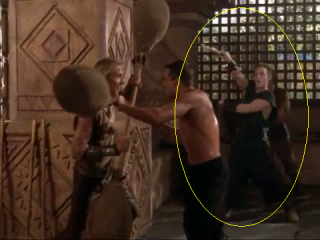Rattan Sticks: Difference between revisions
From YoungHerculesWiki
⧼monobook-jumptonavigation⧽⧼monobook-jumptosearch⧽
No edit summary |
No edit summary |
||
| Line 1: | Line 1: | ||
* Part of [[Weapons Training at the Academy]] | * Part of [[Weapons Training at the Academy]] | ||
* Seen in [[1.06 - | * Seen in [[1.06 - Teacher's Pests]]. | ||
* ''Eskrima, Arnis and (in the West) Kali are umbrella terms for the traditional martial arts of the Philippines that emphasize weapon-based fighting with sticks, knives and other bladed weapons, and various improvised weapons. It also includes hand-to-hand combat and weapon disarming techniques. - [http://en.wikipedia.org/wiki/Rattan_sticks Wikipedia]'' | * ''Eskrima, Arnis and (in the West) Kali are umbrella terms for the traditional martial arts of the Philippines that emphasize weapon-based fighting with sticks, knives and other bladed weapons, and various improvised weapons. It also includes hand-to-hand combat and weapon disarming techniques. - [http://en.wikipedia.org/wiki/Rattan_sticks Wikipedia]'' | ||
* ''The most basic and common weapon in eskrima is the yantok. They are typically constructed from rattan, an inexpensive stem from a type of Southeast Asian vine. Hard and durable yet lightweight, it shreds only under the worst abuse and will not splinter like wood, making it a safer training tool. This aspect makes it useful in defence against blades. Kamagong (ironwood or ebony) and bahi (heart of the palm) are sometimes used after being charred and hardened. These hardwoods are generally not used for sparring, however, as they are dense enough to cause serious injury, but traditional sparring does not include weapon to body contact. The participants are skilled enough to parry and counterstrike, showing respect in not intentionally hitting the training partner. In North America and Europe, eskrima practitioners wear head and hand protection while sparring with rattan sticks, or otherwise use padded batons. - [http://en.wikipedia.org/wiki/Rattan_sticks#Sticks Wikipedia]'' | * ''The most basic and common weapon in eskrima is the yantok. They are typically constructed from rattan, an inexpensive stem from a type of Southeast Asian vine. Hard and durable yet lightweight, it shreds only under the worst abuse and will not splinter like wood, making it a safer training tool. This aspect makes it useful in defence against blades. Kamagong (ironwood or ebony) and bahi (heart of the palm) are sometimes used after being charred and hardened. These hardwoods are generally not used for sparring, however, as they are dense enough to cause serious injury, but traditional sparring does not include weapon to body contact. The participants are skilled enough to parry and counterstrike, showing respect in not intentionally hitting the training partner. In North America and Europe, eskrima practitioners wear head and hand protection while sparring with rattan sticks, or otherwise use padded batons. - [http://en.wikipedia.org/wiki/Rattan_sticks#Sticks Wikipedia]'' | ||
[[Image:Rattan Sticks.png|320px|thumb|left|Rattan Sticks from ''[[1.06 - | [[Image:Rattan Sticks.png|320px|thumb|left|Rattan Sticks from ''[[1.06 - Teacher's Pests]]''.]] | ||
[[Category:Canon]][[Category:Items]][[Category:Weapons]][[Category:Items In 1.06 - | [[Category:Canon]][[Category:Items]][[Category:Weapons]][[Category:Items In 1.06 - Teacher's Pests]] | ||
Latest revision as of 09:13, 11 August 2012
- Part of Weapons Training at the Academy
- Seen in 1.06 - Teacher's Pests.
- Eskrima, Arnis and (in the West) Kali are umbrella terms for the traditional martial arts of the Philippines that emphasize weapon-based fighting with sticks, knives and other bladed weapons, and various improvised weapons. It also includes hand-to-hand combat and weapon disarming techniques. - Wikipedia
- The most basic and common weapon in eskrima is the yantok. They are typically constructed from rattan, an inexpensive stem from a type of Southeast Asian vine. Hard and durable yet lightweight, it shreds only under the worst abuse and will not splinter like wood, making it a safer training tool. This aspect makes it useful in defence against blades. Kamagong (ironwood or ebony) and bahi (heart of the palm) are sometimes used after being charred and hardened. These hardwoods are generally not used for sparring, however, as they are dense enough to cause serious injury, but traditional sparring does not include weapon to body contact. The participants are skilled enough to parry and counterstrike, showing respect in not intentionally hitting the training partner. In North America and Europe, eskrima practitioners wear head and hand protection while sparring with rattan sticks, or otherwise use padded batons. - Wikipedia

Rattan Sticks from 1.06 - Teacher's Pests.